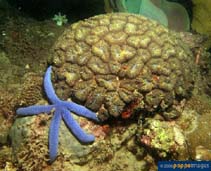Astraeosmilia maxima (Veron, Pichon & Wijsman-Best, 1977)
Классификация / Names народные названия | синонимы | CoL | ITIS | WoRMS
Hexacorallia | Scleractinia | Merulinidae
Environment: milieu / climate zone / пределы глубины / distribution range экология
ассоциированный с рифами; пределы глубины 0 - 35 m (ссылка 848). Tropical; 36°N - 31°S, 32°E - 157°E (ссылка 848)
Distribution страны | регионы FAO | Ecosystems | места находок | интродукции
Indo-West Pacific.
Length at first maturity / Size / Weight / Возраст
половая зрелость: Lm ? range ? - ? cm
Краткое описание морфология
Life cycle and mating behavior половая зрелость | размножение | нерест | Eggs | Fecundity | Larvae
Основная ссылка
ссылки | координатор | соавторы
Veron, J.E.N. and G. Hodgson 1989 Annotated checklist of the hermatypic corals of the Philippines. Pacific Science 43:234-287. (ссылка 8817)
Статус Красного Списка МСОП
(ссылка 130435: Version 2025-1)
Статус СИТЕС (ссылка 108899)
CMS (ссылка 116361)
Угроза для людей
Использование человеком
| FishSource |
инструменты
дополнительная информация
состав пищи
потребление пищи
хищники
Max. ages / sizes
Length-weight rel.
Length-length rel.
Размерный состав
Mass conversion
численность
ресурсы в Интернет
BHL | BOLD Systems | CISTI | DiscoverLife | FAO(Publication : search) | Fishipedia | GenBank (Геном, Нуклеотид) | GloBI | Gomexsi | Google Books | Google Scholar | Google | PubMed | Tree of Life | Wikipedia (Вперёд, поиск) | Zoological Record



